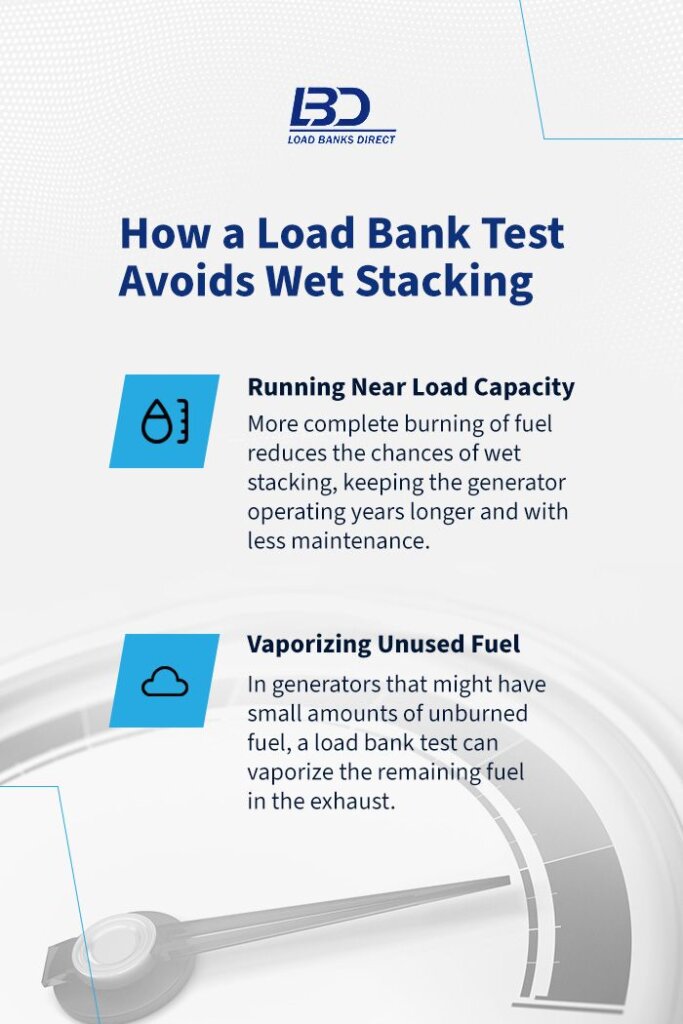
You rely on your generators to start and operate as expected in emergencies. The effects of wet stacking could compromise your generator performance. You can counter this issue by using load banks to prevent wet stacking and protect the life of your power sources. With a load bank, you correct problems that stem from rarely using the generator by exercising the equipment and encouraging it to burn its fuel completely. Discover how load banks can help preserve your generator by preventing wet stacking.
What Is Wet Stacking a Diesel Generator?
In a diesel engine, the exhaust pipes are also known as stacks. The original term “wet stacking” referred to wet unburned fuel and soot depositing on these surfaces.
The National Fire Protection Association (NFPA) defines wet stacking and how to prevent it. Initially, the NFPA guidelines did not mention wet stacking for generators — the information was added to the 1996 and 1999 editions. The organization indicates the presence of carbon or unburned fuel in the exhaust system as indicative of wet stacking.
The most recent version of NFPA 110-2010, which is the Standard for Emergency and Standby Power Systems, outlines testing guidelines. In 2005, the group eliminated the option of testing loads lower than 30% of the nameplate rating for 30 minutes to lower the chances of wet stacking caused by testing the equipment at too low of a power level.
Preventing wet stacking is easier and safer than trying to fix the issue. To correct this problem, run a generator with at least a 75% load to burn off the unburned fuel in the exhaust system. In some cases, this can present a problem because the fuel could ignite. Therefore, to safely start and run a generator without a history of regular testing or exercising after you know wet stacking has occurred, have a professional conduct the load bank test.
Why Is Generator Wet Stacking a Problem?
The effects of wet stacking are more than wasted fuel. This issue causes multiple problems for operation, including the following:
Increased Pollution
A generator with wet stacking issues creates higher levels of pollution. The output of soot and unburned diesel increases emissions from the unit, which could impact the air quality of the immediate area.
Reduced Maximum Power
Wet stacking will reduce the overall maximum power the generator can produce over time. Generators that cannot produce enough power will not work as expected. As a result, facilities that use these systems in outages could find their operating capacity compromised by the wet stacking generator.
Shortened Life Span
Wet stacking reduces the longevity of generators. Instead of lasting for an expected time, the damaged generator could require replacement years sooner. Over the life of the building, more frequent generator replacements will greatly increase operating costs.
Higher Maintenance Requirements
The reduced capacity and shorter lives of generators damaged by wet stacking also come with the increased expenses of higher maintenance requirements. These generators may have more frequent problems and need regular care at shorter intervals than properly working generators.
Progressive Decline
Wet stacking is a problem that grows over time. Fuel nozzles in cylinders develop carbon soot deposits when the generator shows wet stacking signs. These deposits reduce the ability of the fuel to properly atomize inside the engine for complete burning. The leftover fuel that did not burn inside the engine goes to the exhaust system, where it creates damp, dark wet stacking deposits on the exhaust pipes.
With more wet stacking, more fuel goes unburned, which contributes to greater carbon deposits on the fuel nozzles and exhaust system. This cycle creates constantly worsening issues with operations until it is corrected.

Signs and Sources of Wet Stacking
Wet stacking will produce some obvious signs during operation of the generator. Understanding how this problem happens will also help you see why prevention is so critical and how damaging wet stacking is to your generator’s operation.
Signs of Wet Stacking
The biggest signs of wet stacking are soot or wet deposits on the exhaust system of the generator. Engines with turbochargers may also have buildup appear around this component. Generators that have had this problem for a long time and continue operations may have reduced capacity or break down more frequently.
Causes of Wet Stacking
Wet stacking happens when operating a diesel generator under a light load. This load does not allow the engine to reach a temperature sufficient to burn all the diesel during combustion, so unburned fuel leaves the engine and condenses in the exhaust system. The combined unburned fuel and carbon in the exhaust create the signature wet deposits at the end of the exhaust system.
Soot also deposits in other places, such as the fuel injection nozzles, which prevents even dispersal of the diesel into the engine. Therefore, when fuel does not burn completely, the chances of future incomplete burning will increase, resulting in worsening wet stacking.
How a Load Bank Test Avoids Wet Stacking
Load bank testing prevents wet stacking when done correctly, as it provides the generator with adequate load to prevent the system from operating below ideal temperatures and leaving fuel unburned. The following highlights how correct load bank tests prevent wet stacking and its subsequent issues.
Running Near Load Capacity
Wet stacking occurs when the engine does not run at a load high enough to properly raise its temperature. Correctly conducted load bank tests should run the engine with sufficient load to reach the minimum exhaust temperature set by the manufacturer. By operating at loads high enough to reach minimum exhaust temperatures, the engine will heat up enough to permit more fuel burning within the combustion chambers. More complete burning of fuel reduces the chances of wet stacking, keeping the generator operating years longer and with less maintenance.

Vaporizing Unused Fuel
In generators that might have small amounts of unburned fuel, a load bank test can vaporize the remaining fuel in the exhaust. A remedy for wet stacking is to run the generator for a few hours at 75% of its load capacity to raise the temperature high enough to burn off fuel. This method works best for minor cases.
Generators with a history of wet stacking or serious fuel buildup in the exhaust can have their unburned diesel ignite at the high temperatures generated by this method. Engines with serious buildup need thorough evaluations before load bank testing.
Conducting a Load Bank Test
Recommendations for how to conduct a load bank test have changed over the years. With the realization of the dangers of wet stacking, the NFPA no longer outlines how to conduct testing at lighter loads than those in its current guidelines.
To prevent wet stacking, there are two main ways to perform a load bank test per the NFPA 110 8.4.2, which are the following:
Testing Based on Minimum Exhaust Temperature
The first way to conduct a load bank test requires knowing the load needed to achieve the manufacturer’s recommendations for reaching the minimum exhaust temperature. Measuring the exhaust temperature at varying loads or requesting the information from the generator maker can provide this data.
When conducting a test using this method, allow the generator to run with the exhaust gases at their specified temperature for at least 30 minutes.
Testing Based on Load Capacity
The other method for conducting a load bank test on a generator for wet stacking prevention uses the nameplate rating on the unit. This form of testing requires operating the generator at a load of at least 30% of the nameplate rating for half an hour or longer.
The recommendation from the NFPA for load bank testing prior to 1999 used the nameplate load or the EPSS load. The latter reflects the load of the entire emergency power supply system, including its supporting components. Some people may refer to these tests as 30/50, as these older recommendations required using 30% of the nameplate load or 50% of the EPSS load. Today, only the nameplate load ensures the system reaches optimal temperatures.
Even if you hear the term 30/50 for load bank testing, only use the recommendation of running the generator with at least a 30% load for 30 minutes or longer to have the most effective operation. Conducting a load bank test based on the nameplate rating or the exhaust gas temperature will ensure compliance with the most updated NFPA guidelines for emergency power source maintenance.
How Often Should Load Bank Tests Take Place to Prevent Generator Wet Stacking?
To optimize generator function, you must regularly conduct load bank tests. These tests exercise the generator to keep its components running smoothly, provide feedback on the operation and prevent wet stacking. Load bank testing is such a vital component of ensuring the longevity and operation of generators that it should become a standard maintenance operation.
Frequency for Exercising the Generator With Load Banks
The NFPA 110 breaks down recommendations for generator maintenance based on their level of 1 or 2. Level determination stems from how much a facility will rely on the backup power source in an emergency and whether a generator is essential for protecting human lives in that facility.
Level 1 units provide power for facilities where an outage could result in a loss of life or severe injuries. Hospital and other health care facility generators typically fall into this category since these devices keep life support systems and other lifesaving equipment operating.
Level 2 generators power facilities that do not face life-threatening situations in power outages. For example, data centers and education facilities use these types of generators.
All power sources, regardless of level, require testing at least once a month according to NFPA 110 8.4.2. This test should include running the generator under at least a 30% load for at least 30 minutes. Alternatively, diesel testing loads based on achieving the minimum exhaust temperature for 30 minutes each month also fulfill the NFPA requirements.
In cases where the generator cannot undergo monthly testing or fails a test, it must have an annual exercise per 110 8.4.2.4. This rule indicates the annual test puts the generator under a load of at least 50% of its nameplate rating for 30 minutes. After completing this step, the generator must have an additional load of 75% or more for at least one hour.

Making the Load Bank Exercise Part of Maintenance
Monthly load testing of a generator should become part of the regular maintenance routine. Doing so will minimize the chances of a power source developing wet stacking.
The NFPA recommends maintenance routines come from the following criteria:
- Recommendations from the manufacturer
- Instruction manual guidelines
- NFPA minimum maintenance requirements
- Local authorities governing the use and operation of the power source
These guidelines for establishing your maintenance schedule and methods should help you set up repairs, service and testing. Properly maintained generators that you load test monthly will require less care during each maintenance session and last longer because they will not experience wet stacking.
For all tests, services, inspections and repairs of the power source, keep clear records listing what tasks were performed, the person doing the work and the date. These records verify that your facility managers properly maintain the emergency power sources. The local jurisdiction in charge of monitoring your generator maintenance may request these records, so be sure to have them ready at all times.
Are There Other Ways to Prevent Wet Stacking in Generators?
Load bank testing is the best way to prevent wet stacking of generators while providing the power sources valuable exercise that keeps them operational. Still, there are other options to prevent diesel generator wet stacking.
First, make sure that your generator is properly sized for its application, as an oversized generator will not need to operate at higher loads. Some power demands might put the generator under its expected load when conducting testing, which could be insufficient to create the temperatures needed to burn fuel effectively. Therefore, always check the nameplate load capacity and use 30% of that value as the minimum load during testing.
Another way to prevent wet stacking in your diesel generator is by cleaning the fuel. Aged diesel will degrade, darken and increase the likelihood of incomplete burning. Fuel polishers treat the diesel in your generator’s storage tank to remove sludge, water and other contaminants. Taking these undesirable products out of the fuel allows it to perform as close to new as possible without needing to replace the diesel in the storage tank every few months.

Find the Load Banks You Need for Load Testing Your Generator
Visit us at Load Banks Direct online for your source for standard or customized load banks for your facility. We manufacture several types of load banks to fit specific requirements. Data centers, hospitals and labs rely on our products to ensure their generators will respond when needed. Contact us for more information about how to choose the right type of load bank for exercising and preventing wet stacking in your generator.
We Are Here
To Help
Our team is here to support you and solve your power challenges. Connect with our responsive experts today to learn about our customized power solutions and products.


